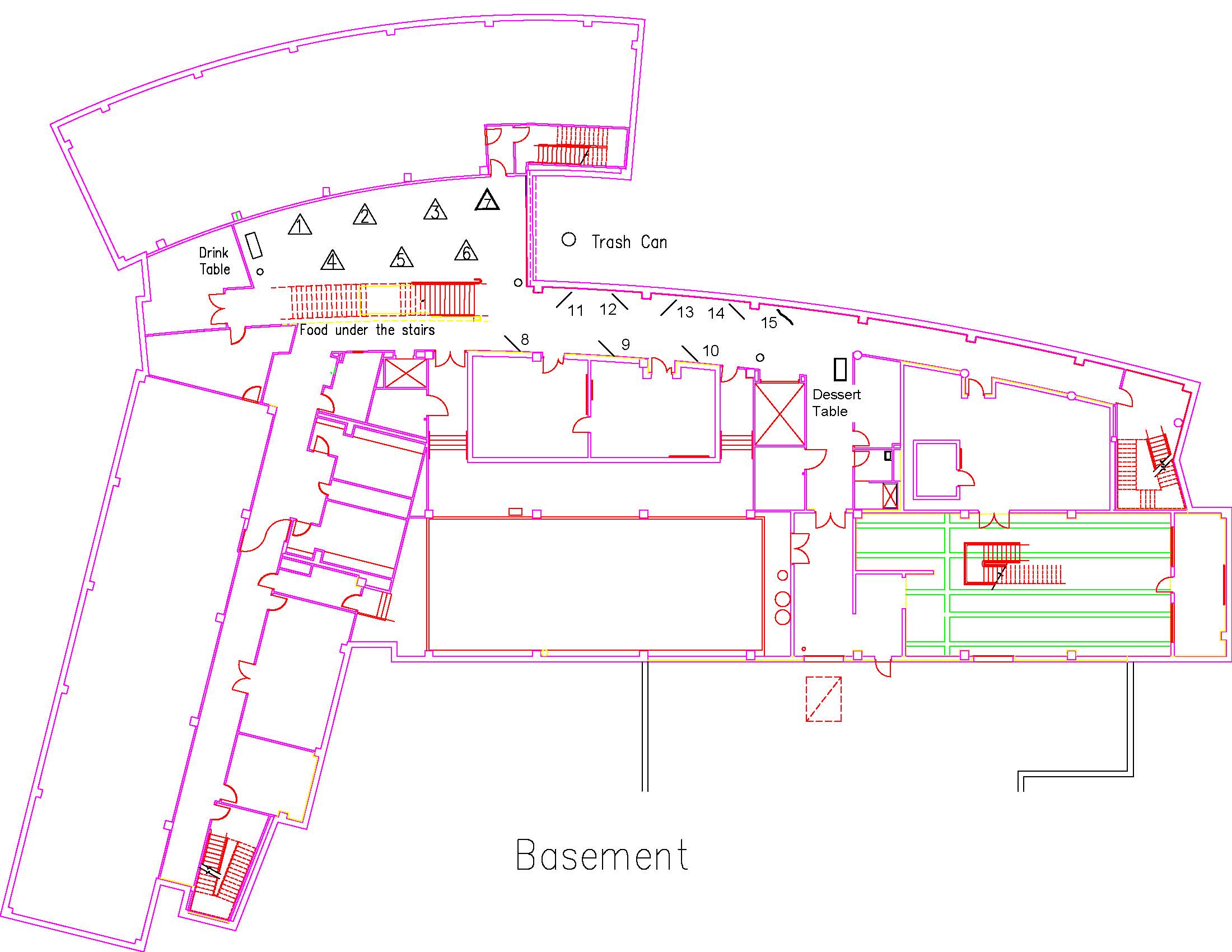BIOL2019JOHNSON36911 BIOL
Connecting Developmental Thyroid Disruption to Impaired Reproductive Success in Fathead Minnows
Type: Graduate
Author(s):
Abigail Johnson
Biology
Advisor(s):
Marlo Jeffries
Biology
Matt Hale
Biology
Location: Session: 2; 1st Floor; Table Number: 6

(Presentation is private)Thyroid disrupting compounds (TDCs) are known to interfere with normal thyroid hormone (TH) signaling. During embryonic and juvenile development, thyroid hormones modulate a variety of biological processes such as neurogenesis and the growth of the skeletal and muscular systems. Therefore, the majority of research on early life-stage (ELS) thyroid disruption has focused on its effects on growth and development. However, recent research has shown that ELS TDC exposure can also have adverse effects on reproduction later in life. Specifically, fathead minnows exposed to propylthiouracil (PTU), an anti-thyroid drug known to inhibit the synthesis of thyroxine (T4), during early development (from hatch through 42 days post hatch) experienced a 50% reduction in fecundity relative to controls. Interestingly, this statistically significant reduction in fecundity occurred when males, but not females, were subjected to ELS PTU exposures. After ruling out the possibility that ELS thyroid disruption altered testicular function, it was hypothesized that the observed reductions in fecundity resulted from changes in male reproductive behavior. To investigate the potential for and mechanism underlying PTU-induced alterations in male behavior, brains of PTU-exposed and control males were collected immediately after exposure for transcriptomic analysis. Of the genes that were found to be differentially expressed between the brains of PTU-exposed and control males, several were associated with axon guidance, behavior, and sex steroid signaling. Specifically, PTU-exposed males experienced significant reductions in the expression of serotonin receptor, fibronectin, estrogen receptor alpha, and aromatase. Given the known role of these genes in development and sexual differentiation of the male brain, these results provide evidence supporting the hypothesis that ELS chemically-induced hypothyroidism leads to altered neurogenesis and subsequent alterations in behavior. Overall, the results of this study may help link transcriptomic alterations in the brain to alterations in reproductive behavior, which has important population-level consequences.
BIOL2019KRZYKWA27064 BIOL
Validating methods for the assessment of neurological function in larval fathead minnows
Type: Graduate
Author(s):
Julie Krzykwa
Biology
Gabby Lamanteer
Biology
Advisor(s):
Marlo Jeffries
Biology
Location: Session: 1; Basement; Table Number: 5

(Presentation is private)Alterations in neurological development and/or vision have been noted after exposures to a variety of environmental contaminants, including heavy metals, pesticides, pharmaceuticals, and estrogens. Despite the growing interest in assessing the neurotoxicity of toxicants, routine toxicity testing methods do not currently include the assessment of endpoints capable of predicting adverse impacts on neurological development. A toxicity test featuring embryonic fathead minnows - the fish embryo toxicity (FET) test - was recently developed; however, it does not include neurological-related endpoints. Development of such endpoints would expand the utility of the FET test and allow for the assessment of neurological teratogens. Previous studies have identified embryonic eye size as a potential FET test endpoint, and though there is limited evidence suggesting that these alterations are indicative of altered neurological development, studies validating the link between eye size and organism fitness are needed. The overarching goal of this project is to investigate whether reduced embryonic eye size at the conclusion of the FET test is predicative of altered vision or neurological function in larval fathead minnows. But first, assays for assessing vision and neurological function in larval fathead minnows must be developed and/or validated. Therefore, the objective of the present study was to validate methods to assess vision/neurological function in larval fathead minnows. Three assays were developed: the optomotor response assay, a feeding assay, and the c-start assay. The ability of these assays to identify alterations in the neurological function of larval fathead minnows was assessed by exposing larvae to three doses of the known neurotoxicant chlorpyrifos for 5 or 12 d. These results will be utilized in future studies investigating whether reductions in embryonic eye size are predictive of sublethal adverse effects and can also be utilized by other researchers interested in assessing vision/neurological function in larval fathead minnows.
BIOL2019MIRKIN43123 BIOL
Predation Release of Texas Horned Lizards (Phrynosoma cornutum) Living In Small Towns
Type: Graduate
Author(s):
Stephen Mirkin
Biology
Mary Rachel Tucker
Biology
Advisor(s):
Dean Williams
Biology
Location: Session: 1; Basement; Table Number: 1

View PresentationTexas horned lizards Phrynosoma cornutum are a threatened species in the state of Texas, due to population declines and extinctions, especially in the eastern part of their range. Texas horned lizards are still found in small towns in south Texas and can reach densities that are much higher (~50 lizards/ha) than in natural areas (~4-10 lizards/ha). We used models of Texas horned lizards to test whether predation levels might be lower in two south Texas towns than on a ranch that was located in south Texas. We constructed Texas horned lizard models from urethane foam, a material that is ideal for preserving marks (bites and pecks) left behind by predators. Models (n = 126) were left in the field for a period of 9 days in each location and marks left behind by predators were categorized accordingly. We conducted this experiment in June and again in August 2018. We found significantly less attempted predation events in the towns (n = 1 predation attempt) compared to the ranch (n = 60) and no differences between months. Anecdotal observations over the past 6 years also support a lack of many horned lizard predators in the towns. Our results suggest that Texas horned lizards may be under heavy predation pressure in natural environments and that lizards living in urban areas may be escaping some of this pressure leading to higher than normal lizard densities in some small Texas towns.
BIOL2019RHOADS18920 BIOL
Camouflage in Conservation: Background Color-Matching in the Texas Horned Lizard (Phrynosoma cornutum)
Type: Graduate
Author(s):
Dustin Rhoads
Biology
Dean Williams
Biology
Advisor(s):
Dean Williams
Biology
Sarah Hill
Psychology
John Horner
Biology
Laura Luque
Biology
Location: Session: 2; 3rd Floor; Table Number: 8

View PresentationMost of the literature on the basic ecology of Texas Horned Lizards cites "cryptic color pattern" as the first line of defense against predation in this taxon, and yet the degree to which horned lizards actually color-match their backgrounds has never been quantified. Texas zoos and state wildlife agencies are releasing captive-bred hatchlings and translocated adults to parts of their former range; however, the new populations are not self-sustaining, with the majority of releases lost to predation. Background color-matching has not been quantified for these reintroduction efforts but may be important to take into account when moving lizards into a new habitat where predation may be higher if they are not closely color-matched to the local soils. I quantify background color-matching in this taxon across its known range in the United States and in Mexico from in situ photos taken, as found, in the wild. I also present background color-matching variation and trends both within and between phenotypically and genetically diverse populations and ask whether lizards more closely match their local soil colors than soils from other areas. Finally, I suggest a method for zoos and wildlife agencies to score coloration in their captive populations of lizards, thus possibly enabling these institutions to objectively take into account color-matching a priori as an applied conservation strategy to potentially increase the survival of reintroduced Texas Horned Lizards.
BIOL2019SCHENK52240 BIOL
Comparative Disturbance Response Between Two Closely Related Avian Species
Type: Graduate
Author(s):
Amber Schenk
Biology
Advisor(s):
Amanda Hale
Biology
Tamie Morgan
Geological Sciences
Location: Session: 1; Basement; Table Number: 1

(Presentation is private)Indigo Buntings (Passerina cyanea) and Painted Buntings (Passerina ciris) are closely related songbirds in the family Cardinalidae, found to co-exist in areas where ranges overlap. However, though both species share similarities in morphology, diet and preferred habitat characteristics, there is little quantitative data accumulated about the Painted Bunting and many aspects of its life history remain unclear. North American Breeding Bird Surveys have shown a significant decline in Painted Bunting population numbers across their ranges—a decline that has resulted in its designation of a Species of Special Concern by Partners in Flight. Proposed reasons for the decline include habitat destruction, sensitivity to disturbance and factors associated with decreased success in breeding. Within the Great Trinity Forest, the Indigo and Painted bunting’s breeding grounds overlap. The Great Trinity Forest is a large urban forest surrounded by the city limits of Dallas, TX containing a variety of disturbance factors characteristically associated with a highly urbanized area: poor habitat, invasive species, and increased noise and light. Sensitive species, such as the Painted Bunting, are typically found to avoid areas of disturbance. Data collected May-July 2018 shows presence/absence of both species within 140, 5 ha plots spanning the forest. Additional disturbance data was collected, including noise levels (db), invasive wild hog activity and percent impervious surface both within and surrounding each study site. Analysis of this data will aid in discovering how these species distribute themselves in relation to disturbance factors, urbanization and each other. Results will further serve to assist in future conservation efforts and increased life history knowledge of the painted bunting. It is predicted that disturbance factors within the Great Trinity Forest have a significant effect on Painted Bunting presence/absence while they have no significant effect on the Indigo Bunting.
BIOL2019THALHUBER31251 BIOL
Methyl Mercury Contamination and Diet of Nestling Red-winged Blackbirds
Type: Graduate
Author(s):
Thomas Thalhuber
Biology
Matthew Chumchal
Biology
Ray Drenner
Biology
William Zudock
Biology
Advisor(s):
Matthew Chumchal
Biology
Ray Drenner
Biology
Location: Session: 2; 2nd Floor; Table Number: 7

(Presentation is private)Red-winged blackbirds (Agelaius phoeniceus) are found throughout North America, often nesting in cattails in ponds and wetlands. Diet studies have revealed that adults can feed their nestlings both emergent aquatic insects like odonates and terrestrial insects like lepidopteran larvae. Because emergent aquatic insects can be contaminated with high amounts of methyl mercury (MeHg), it has been hypothesized that nestlings fed high amount of odonates would be contaminated with levels of MeHg that are hazardous to their health. There have been no of studies of MeHg contamination of nestling Red-winged blackbirds and their diet. The objective of our study was to measure the concentration of MeHg in blood of nestling Red-winged blackbird and to estimate the proportion of emergent aquatic insects and terrestrial insects in their diet. We conducted a study of Red-winged blackbird nestlings at 20 ponds at the Eagle Mountain Fish Hatchery, Fort Worth, Texas. The ponds are contaminated with Hg from the atmosphere. Previous studies at the Hatchery have demonstrated that emergent aquatic insects such as odonates have high concentrations of MeHg while terrestrial insects on the pond shorelines have low concentrations of MeHg. Red-winged blackbirds nested in cattails in the ponds from April 9 to July 30 2017. We collected 424 blood samples from 243 nestlings from 88 nests (1-2 samples from 1-4 nestlings per nest). We analyzed the blood for MeHg, and analyzed 202 of the blood samples (1-2 blood samples from 1 per nest) for nitrogen stable isotopes. Methyl mercury was detected in nestling blood suggesting that Red-winged blackbird nestlings were fed emergent aquatic insects. However, concentrations of MeHg in nestling blood were low (mean of 0.020 ug/g ww) and below the risk threshold. Methyl mercury concentrations and nitrogen stable isotope ratios for Red-winged blackbird nestlings suggest that terrestrial insects composed a high proportion of their diets. Our study suggests that Red-winged blackbird nestlings may not be at risk of MeHg contamination when terrestrial organisms dominate their diet.
BIOL2019WINER58088 BIOL
Floral Herbivory in a Carnivorous Plant
Type: Graduate
Author(s):
Zane Winer
Biology
Advisor(s):
John Horner
Biology
Location: Session: 2; 3rd Floor; Table Number: 2

(Presentation is private)Floral herbivory (florivory) can have direct effects on both female and male reproductive output. Damage to flower parts such as petals and anthers can also have potential indirect effects by altering floral attractiveness to pollinators. Because carnivorous plants live in nutrient-poor environments and have slow growth rates, these plants may be at increased risk of negative effects of florivory. However, there has been no study to investigate florivory in carnivorous plants. We conducted a two-year field study on an east-central Texas population of the carnivorous pitcher plant Sarracenia alata and its specialist herbivore Exyra semicrocea. Populations were surveyed for number of flowers attacked, and the mass of floral components was compared between attacked and unattacked flowers. In 2017, a mean of 65% of flowers were attacked at the end of the flowering season. Based on mass before dehiscence, the mass of anthers after florivory was 49.5% of unattacked anthers. There were no significant differences in the masses of other floral structures at the end of the season. In 2018, 38% of flowers surveyed were attacked. The mass of attacked ovaries was 47% that of unattacked, the mass of sepals and petals combined was 62.5% that of unattacked, and the stigma/style complex was 51.0% that of unattacked. The mass of attacked anthers before dehiscence was 18.7% that of unattacked anthers. This study shows that there was annual variation in both the proportion of flowers attacked in the population, and the extent of damage seen in floral structures. Future studies should examine the effects of florivory on pollen limitation, pollinator behavior, and recruitment in Sarracenia alata.
CHEM2019BEERI11498 CHEM
Using Surface Polymer Networks to Connect DSPEC Components for a High Solar Energy Conversion Efficiency
Type: Graduate
Author(s):
Debora Beeri
Chemistry & Biochemistry
Advisor(s):
Benjamin Sherman
Chemistry & Biochemistry
Location: Session: 1; Basement; Table Number: 5

View PresentationIt is extremely important in our age to look for alternative, more environmentally favorable energy sources. The Sun is a largely unused and widely available energy source to power human industry which can be utilized in different ways. Photovoltaic cells directly convert solar energy to electricity but only provide power when illuminated. Supplying solar-sourced energy during night hours and inclement weather requires conversion to another form, for instance into chemical fuel by means of water splitting into oxygen and hydrogen. This strategy, inspired by natural photosynthesis, is currently a promising and actively researched approach. However, achieving a high energy conversion efficiency, which is essential for industrial implantation of the method, remains a primary goal.
A Dye-Sensitized Photoelectrochemical Solar Cell (DSPEC) is specifically designed for using solar energy to generate hydrogen from water. We are pursuing the formation of photoanodes with polymer surface coatings prepared by electropolymerization. The polymer interfaces are designed to promote directional electron transfer at the interface, thereby resulting in a better solar energy conversion efficiency. The structure of the surface polymer enables the incorporation of catalyst units to the interface. To this end, we have prepared several novel iridium-oxide nanoparticle suspensions, using two different synthetic methods, to serve as the water-oxidation catalysts in our system. During the synthesis, the nanoparticles are functionalized with specific capping groups that contain terminal double bonds, through which they can be incorporated to the surface polymer electrochemically. Using acrylic acid and acrylamide as small molecule precursors, electro-polymer coatings have been prepared on FTO (fluorine-doped tin oxide) surfaces. Future research work will involve the incorporation of functionalized iridium oxide nanoparticles in the poly(acrylic acid/acrylamide) films and the characterization of their catalytic activity toward water oxidation. The method will then be extended to tin-oxide and titanium-dioxide semiconductor electrodes for preparing photo-active interfaces.
CHEM2019CASTILLO16416 CHEM
RATIOMETRIC MOLECULAR ROTORS FOR DETERMINING PHASE-TRANSITIONS OF SOFT MATERIALS
Type: Graduate
Author(s):
Marlius Castillo
Chemistry & Biochemistry
Zygmunt Gryczynski
Physics & Astronomy
Zhangatay Nukureyev
Physics & Astronomy
Advisor(s):
Sergei Dzyuba
Chemistry & Biochemistry
Location: Session: 1; Basement; Table Number: 3

(Presentation is private)Soft matter, such as organogels, waxes and polymer films have found numerous applications in various areas of sciences, engineering and medicine. Ability to assess and monitor their structural organization and physical properties is of the outmost importance. However, there are no convenient methods to accomplish this task.
Small molecule environmental probes have been instrumental in providing information about changes of various types of media upon exposure to external stimuli. Our group has demonstrated the validity of using these probes, also known as molecular rotors, for investigating various types of media. This poster will highlight our efforts on the developments and applications of ratiometirc molecular rotors that allow determining structural integrity as well as properties of various industrially important, medically- and energy-relevant soft matter materials.
CHEM2019FAHIM64637 CHEM
Unusual Liquid-liquid Phase Separation of Lysozyme Aqueous Solutions at Physiological pH and Salt Concentration
Type: Graduate
Author(s):
Aisha Fahim
Chemistry & Biochemistry
Advisor(s):
Onofrio Annunziata
Chemistry & Biochemistry
Location: Session: 1; 3rd Floor; Table Number: 1

View PresentationLiquid-liquid phase separation (LLPS) of protein aqueous mixtures is the reversible condensation of protein-rich micro droplets occurring below a well-defined LLPS temperature. LLPS studies of protein mixtures are fundamental for understanding the membrane-less compartmentalization inside living cells, protein-aggregation diseases, protein-based drug formulations, enzyme-based materials and molecular interactions. It is known that aqueous solutions of the protein lysozyme in the presence of phosphate buffer at neutral pH and physiological salt concentration undergo LLPS upon cooling below ≈ 0 °C. The obtained lysozyme-rich micro droplets rapidly dissolve upon heating above the LLPS temperature. In this work, it will be shown that an apparently undisruptive substitution of phosphate buffer with another well-known buffer, 4-(2-hydroxyethyl)-1-piperazineethanesulfonate (HEPES), to lysozyme aqueous solutions significantly alter the LLPS mechanism. Specifically, contrary to the case of phosphate buffer, the micro droplets produced below ≈ 0 °C remain surprisingly stable upon heating even at ≈ 30-40 °C. Related LLPS studies in both acidic and basic conditions show similar anomalous LLPS behavior. Our results indicate that HEPES triggers a second protein self-assembly process that is catalyzed by LLPS. These findings show that protein aqueous mixtures in the presence of HEPES buffer could be exploited for the preparation of protein-based materials. They also suggest that the combination of a protein self-assembly with LLPS may be a mechanism involved in the formation of membrane-less globular compartments inside the cytoplasm of living cells.